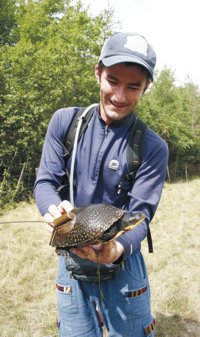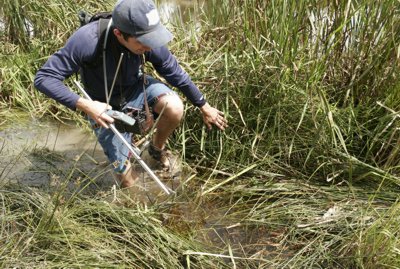WHEN I CAUGHT UP WITH Brennan Caverhill this past July in Pleasant River, Nova Scotia, he told me he hadn't seen Ela the turtle since the wee hours of a mid-June morning. Under a starry sky, Caverhill found her clawing away the gravelly earth on the side of an old railway bed. “Ela always lays eggs between one and three in the morning, and it can take her up to seven hours to finish” he explains. After she loosed several rubbery eggs and covered up the hole as if nothing had happened, she trundled down a bank then vanished into a lush stand of marsh brush - never to return to her nest.
For his part, Caverhill placed a screened wooden frame over the turtle's nest to prevent predators and off-the road-vehicles from destroying it before the eggs hatch. The design allows sunlight to warm the nest and incubate the eggs. If all goes well, sometime this month or next, Ela's hatchlings will dig their way to the surface. At that point, Caverhill and volunteers will measure and mark those under the nest screens before releasing them.
The newborns will foray into a perilous and uncertain world. It is estimated that one percent of Blanding's turtles survive to adulthood. About the size of a Canadian toonie [a two-dollar coin], most are eaten by raccoons or birds, or are killed while crossing roads to reach waterways.
For years, researchers in Nova Scotia have been trying to change those odds. Caverhill is among a team of biologists and volunteers working within and outside the boundaries of Kejimkujik National Park trying to save the endangered turtle from extinction. Inside the park, the strategy includes familiarizing the public with Blanding's turtle habitat, helping people recognize them in the wild and getting vehicles to slow down on roads near areas where the turtles nest by using signs and speed bumps to prevent young turtles from being run over. Another park program rears hatchling turtles for two years before releasing them back into the wild in hopes of increasing their likelihood of survival.
Caverhill's research focuses on one of two known populations beyond the park boundaries. He also works full-time on outreach and stewardship within the community.
Nova Scotia zoologist Sherman Bleakney found the province's first Blanding's turtle in 1953 living near Kejimkujik Lake. Over the course of time, researchers discovered two separate and distinct populations outside the park near the Pleasant River and McGowan Lake. Totaling less than 300 adult Blanding's turtles, the populations constitute the northern edge of the species' North American range. These turtles are also genetically and behaviorally distinguishable from Blanding's turtles in other parts of Canada and the United States.
Most likely, Caverhill says, the freshwater turtles colonized here during a warm period after the last glaciation, some 5,000 years ago. Then about 3,000 years ago, the land bridge connecting Nova Scotia to New Brunswick was flooded and became salt marsh, preventing further colonization. Following that, the climate cooled, restricting the species to this small area in south central Nova Scotia where the mean annual temperature is higher than in any other region in the Maritimes. As vestiges of when Nova Scotia was still connected to the main land, researchers deem these “relict populations.” The turtle was listed in Nova Scotia as threatened in 1990 and endangered in 2000.
To find the turtles, researchers use sardines and soy oil to lure the reptiles into netted traps. Once captured, they're measured, weighed and given small identification notches on the rim of their shells. Many of the adult turtles, like Ela, have been fitted with radio transmitters, which weigh a fraction of their body weight. Those turtles in turn, have led researchers to where other turtles live.
On this day, Caverhill carries his radio receiver attached to a directional antennae, which can pick up pulses from Ela's transmitter from up to two kilometers, or 1.2 miles away. We begin our search down the railway bed through a marshland at the foot of a grassy drumlin. Thick with meadowsweet, sweet gale, pickerel weed and sedges - vegetation Blanding's thrive on, Caverhill knows this lush and sheltered landscape well.
Since of spring of 2002, when he was a graduate student at Acadia University, Caverhill has been documenting the distribution, movements, behavior and habitat use of the Pleasant River Blanding's turtle population. While the park and McGowan Lake populations have varying degrees of government protection, Pleasant River is a farming community with private landholdings. To make headway into the community, he rented a room in the home of Winnie Allen, a life-long resident and supporter of Caverhill's outreach project. Her home overlooks the very same marshlands where Caverhill and his colleagues have spent years researching.
“Winnie introduced me to her friends and family and pretty soon the work got out about the turtle project,” Caverhill says. Before long, many residents were eager to tell him where and when they spotted turtles, and a few have become fervent volunteers. Some have hosted and protected nests on their land.
A few locals, though, found Caverhill, and his mission to protect an endangered species, a threat to their way of life. In one instance, a couple of teenage boys, convinced that this young biologist was out to prevent them from riding their dirt bikes along the railway bed, scribbled profanity on a bridge crossing the Pleasant River. The graffiti mildly translated into “To heck with the turtles.”
At the same time, ATV riders and young bikers who use a nearby sandpit have avoided and protected caged turtle nests. Now when he meets kids on dirt bikes, Caverhill says, “I talk to them mainly about their bikes, cars and things that they're interested in. Then I'll talk about the turtles. You see more results when you aren't con-frontational.
“The thing is, though, I'm genuinely interested in just about everything. Whether it's dirt bikes or when Winnie talks about canning or knitting.”
As part of his outreach project, Caverhill sets up his turtle booth at county fairs, speaks with school children and local groups and has toured with a theatre group from Halifax to dramatize the plight of the turtle. This fall, he hopes to attach a small caravan on the back of his bicycle in the shape of a turtle shell and circuit ride to area schools.
| “So it goes, that if you meet a turtle when you're young, you may form that association for the rest of your life.” ”
|
To make people feel they have a stake in the recovery project, Caverhill will often name a turtle after its discoverer or after someone who helps out. Sometimes the name just comes naturally.
“Let's see, there's Turner, Allen, Spurr, One-eyed Wink, Stump with one hind leg…,” Caverhill recites. “And of course, there's Ela.” She was discovered by a friend of Caverhill's a few years back. The name comes from Sanskrit meaning earth. Caverhill has determined that she's around 28 years old and has probably produced five clutches, or nests.
“Scientist would cringe to hear me anthropomorphizing,” Caverhill says. “But the point is, turtles do have personalities - and they are consistent. Some are totally relaxed; others tuck right into their shells and don't peek out for hours. Others are mean, some are smarter, like Shy, who can flip lids off sardine cans.”
In short, “It's just a really cool turtle,” he says about the Blanding's.
One day, he adds, he might like to settle down in Pleasant River. He draws an analogy between the people who live in this region and the turtles, which can live up to 80 years or more.
“People return here generation after generation. There's a clear sense of place and history. In a way, the turtles parallel the history of the people. So it goes, that if you meet a turtle when you're young, you may form that association for the rest of your life.”
We backtrack down the railway bed, past Ela's nest, into another marsh, then head back down the road, but with no luck. Once we take a right on to a gravel road, Caverhill holds up his directional antennae and points it toward the southeast. The pulses intensify.
“Sounds like she must be up at Dick Allen's farm,” Caverhill deduces. We load our gear into Caverhill's minivan, cruise down the road and take a sharp turn up another steep drumlin. We find Dick Allen, Winnie's former husband, coming out his house. A cattle farmer, Allen has helped by fencing off a brook to prevent his cattle from crossing turtle habitat. After a nice chat about drumlins and hard winters, the early settlers here and the swallows that nest in his barns, we get Allen's permission to search a fire pond at the edge of his field.
 |
| With a radio receiver and antennae, Caverhill keeps track of the turtles’ movements and habitat. |
As we shimmy under a barbed-wire fence and slog through a soggy field pockmarked by cattle hooves, the pulses from Ela's transmitter grow louder. Within minutes of reaching the pond, Caverhill wades in knee-deep, following the pulses, stops and then scoops Ela out from a clump of sedges.
It is a rarity to see a Blanding's turtle. Unlike snapping or painted turtles that you might spot on a boulder or the side of a stream basking in the sunlight, Blanding's are far subtler and mostly burrow into thick marsh cover. For that reason, and because of its dome-shaped carapace, brilliant yellow and black colorings on its neck and plastron, and an upraised lip that makes the turtle appear as if it's eternally smiling, it's hard not to be transfixed. Caverhill is right on: this is a really cool turtle.
He points these features out to me, briefly, then gently places the turtle back into the same spot. Next he measures and records the depth and temperature of the water and the air temperature. He also makes a note that since he last saw the turtle, she has traveled around one kilometer, or well over half a mile.
Caverhill and his colleagues at Kejimkujik are hoping their efforts will lead to the recovery of the endangered Blanding's turtle population in Nova Scotia over the next two decades.
Already they've amassed volumes about the turtle's genetics, range, reproductive behaviors, hatchling movements and habitat.
The biggest challenge, however, is getting humans to pay attention and invest in the turtle's survival.
As we wind up our interview, Caverhill says he can't ever imagine not educating the public and working to save this animal. “This is my life's work,” he tells me. “I truly believe that people can live with nature and the two can co-exist.”
Looks like he's close to proving that, right here near the banks of the Pleasant River.
For more information go to www.speciesatrisk.ca/blandings/
©
2006 The Gulf of Maine Times


